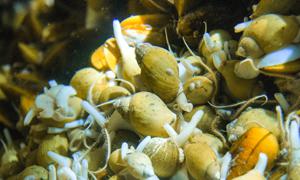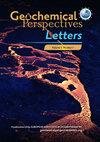Lanthanum anomalies provide constraints on macrofaunal predation at methane seeps
IF 3.7
1区 地球科学
Q1 GEOCHEMISTRY & GEOPHYSICS
引用次数: 0
Abstract
The feeding habits and predation behaviour of organisms can exert significant control on the dynamics of local food webs. Yet, little is known about the effects of predation on the material and trophic transfer dynamics in chemosynthesis-based ecosystems. Here, we investigated the rare earth element (REE) composition of soft tissues and hardparts for thiotrophy-dependent vesicomyid clams (Archivesica marissinica), aerobic methanotrophy-dependent bathymodiolin mussels (Gigantidas haimaensis), in addition to turrid gastropods (Phymorhynchus buccinoides) and parasitic scale worms (Branchipolynoe pettiboneae) from the Haima seeps of the South China Sea; the latter two species are predators feeding on mussels. Our goal was to determine if the specific, microbially-derived, light REE enrichment characteristics of seep mussels can be transferred to the biomass of their predators. The vesicomyid clams were found to exhibit light REE patterns similar to that of seawater. In contrast, the bathymodiolin mussels, turrid gastropods, and scale worms revealed pronounced lanthanum (La) enrichment, agreeing with substantial transfer of La within the local food web. The observed enrichment of La in seep dwelling predators represents an independent method for monitoring the dynamics within seep ecosystems and potentially for assessing faunal interactions in ancient chemosynthesis-based ecosystems.

镧异常为甲烷渗漏区大型底栖生物捕食提供了制约因素
生物的摄食习惯和捕食行为可对当地食物网的动态产生重要的控制作用。然而,人们对捕食对以化学合成为基础的生态系统中的物质和营养传递动态的影响知之甚少。在这里,我们研究了中国南海海马渗漏区依赖硫营养的vesicomyid蛤(Archivesica marissinica)、依赖好氧甲烷营养的bathymodiolin贻贝(Gigantidas haimaensis)、腹足类(Phymorhynchus buccinoides)和寄生鳞片蠕虫(Branchipolynoe pettiboneae)的软组织和硬部分的稀土元素(REE)组成;后两个物种是以贻贝为食的捕食者。我们的目标是确定渗漏贻贝特定的、微生物衍生的轻型 REE 富集特征是否可以转移到其捕食者的生物量上。研究发现,膀胱贻贝表现出与海水类似的光 REE 模式。与此相反,水底贻贝、腹足类和鳞片蠕虫则显示出明显的镧(La)富集现象,这与镧在当地食物网中的大量转移是一致的。在渗漏栖息的捕食者体内观察到的 La 富集现象是监测渗漏生态系统内部动态的一种独立方法,有可能用于评估以古化学合成为基础的生态系统中动物的相互作用。
本文章由计算机程序翻译,如有差异,请以英文原文为准。
求助全文
约1分钟内获得全文
求助全文
来源期刊

Geochemical Perspectives Letters
Earth and Planetary Sciences-Geochemistry and Petrology
CiteScore
7.00
自引率
2.00%
发文量
42
审稿时长
15 weeks
期刊介绍:
Geochemical Perspectives Letters is an open access, internationally peer-reviewed journal of the European Association of Geochemistry (EAG) that publishes short, highest-quality articles spanning geochemical sciences. The journal aims at rapid publication of the most novel research in geochemistry with a focus on outstanding quality, international importance, originality, and stimulating new developments across the vast array of geochemical disciplines.
 求助内容:
求助内容: 应助结果提醒方式:
应助结果提醒方式:


